

Overview You no doubt know that animation plays an important role in creating eye-catching web applications. As users increasingly turn their attention to user experience, merchants are beginning to realize the importance of a flawless, enjoyable user experience, and as a result, web applications are becoming heavier and with more dynamically interactive UIs. This all requires more complex animations to allow users to transition from state to state more smoothly throughout the process. Today, this is not even considered anything special. Users are becoming increasingly picky and, by default, expect highly responsive and interactive user interfaces. However, animating the interface is not necessarily simple. What is animation, when should animation be used, and what kind of video effects should animation have? These are all thorny questions. JavaScript and CSS Animation Comparison The two main methods of creating web animations are using JavaScript and CSS. There is no right or wrong choice, it all depends on the effect you want to achieve. CSS Animation Animate with CSS The easiest way to make elements move on the screen. Here's going to start with a simple example of how to make an element move 50px on the X and Y axes, using a CSS transition that lasts 1 second.##Related free learning recommendations:javascript(Video)
.box { -webkit-transform: translate(0, 0); -webkit-transition: -webkit-transform 1000ms; transform: translate(0, 0); transition: transform 1000ms; } .box.move { -webkit-transform: translate(50px, 50px); transform: translate(50px, 50px); }
moveclass, the value oftransformis changed and the transition effect occurs.
easingattribute, which is actually the movement speed of the animation. This parameter will be introduced in detail later.
p class="box"> Sample content.
var boxElements = document.getElementsByClassName('box'), boxElementsLength = boxElements.length, i; for (i = 0; i The above code snippet is to add the move class to all elements containing the box class to trigger animation.
Doing this can provide a good balance for your application. You can focus on managing state using JavaScript, just set the appropriate class on the target element and let the browser handle the animation. If you go this route, you can listen to the transitionend event on the element, but only if you drop support for older versions of Internet Explorer:

Listeningtransitionend The triggered event is as follows:
var boxElement = document.querySelector('.box'); boxElement.addEventListener('transitionend', onTransitionEnd, false); function onTransitionEnd() { // Handle the transition finishing. }
Copy after login
.box { /* 动画的名字 */ animation-name: movingBox; /* 动画的持续时间 */ animation-duration: 2300ms; /* 动画的运行次数 */ animation-iteration-count: infinite; /* 设置对象动画在循环中是否反向运动的方法 */ animation-direction: alternate; } @keyframes movingBox { 0% { transform: translate(0, 0); opacity: 0.4; } 25% { opacity: 0.9; } 50% { transform: translate(150px, 200px); opacity: 0.2; } 100% { transform: translate(40px, 30px); opacity: 0.8; } }
var boxElement = document.querySelector('.box'); var animation = boxElement.animate([ {transform: 'translate(0)'}, {transform: 'translate(150px, 200px)'} ]) animation.addEventListener('finish', function() { boxElement.style.transform = 'translate(150px, 200px)'; })
finishevent and set thebox.style.transformproperty totranslate(150px, 200px), which value It's the same second style transition performed by CSS animations.
当然,没有任何东西从一个点到另一个点线性移动。 实际上,当事物在我们周围的物理世界中移动时,事物往往会加速或减速,因为我们不是在真空中,并且有不同的因素会影响这一点。 人类的大脑会期望感受这样的移动,所以当为网络应用制作动画的时候,利用此类知识会对自己会有好处。
以下是一些术语需要了解一下:
CSS 过渡和动画允许你选择要使用的easing类型。 不同的关键字会影响动画的easing,你也可以完全自定义easing方法。
以下为可以选择用来控制easing的 CSS 关键字:
让我们深入来了解一下这几个兄弟,并看它们各自展示的效果是怎么样。
easing方法的的默认为linear,以下为 linear 过渡效果的图示:
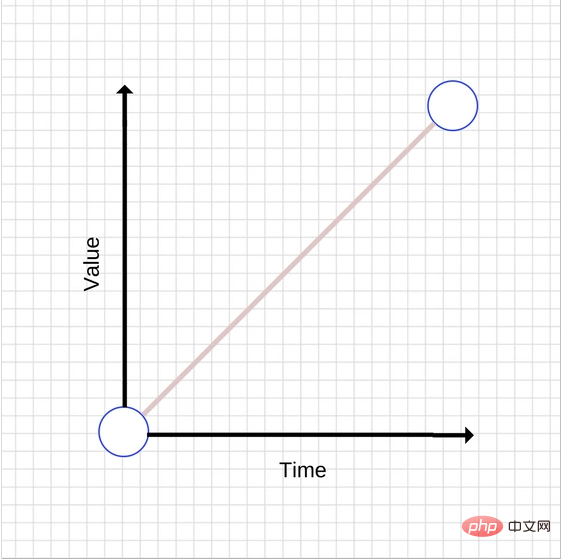
随着时间增加,值等比增加,使用linear动效,会让动画不自然,一般来说,避免使用linear动效。
以下是如何实现简单的线性动画:
transition: transform 500ms linear;
如前所述,与线性动画相比,easing out动画开始时快,结束时候间慢,过渡效果的图示如下:
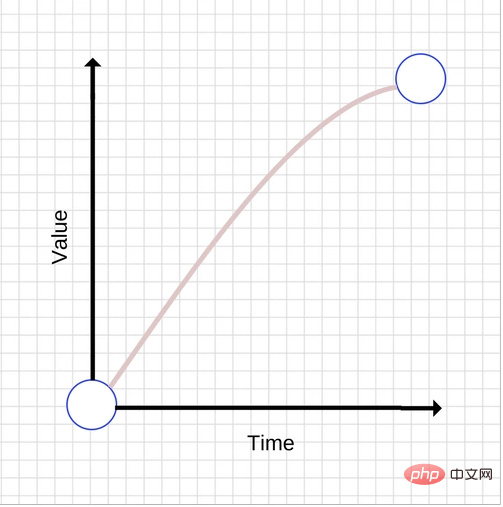
一般来说,easing out过渡效果是最适合做界面体验的,因为快速地启动会给人以快速响应的动画的感觉,而结束时让人感觉很平滑这得归功于不一致的移动速度。
有很多方法可以实现ease-out效果,但最简单的是 CSS 中的ease-out关键字:
transition: transform 500ms ease-out;
和ease-out动画相反-开始时快,结束时候间慢,过渡效果图如下:
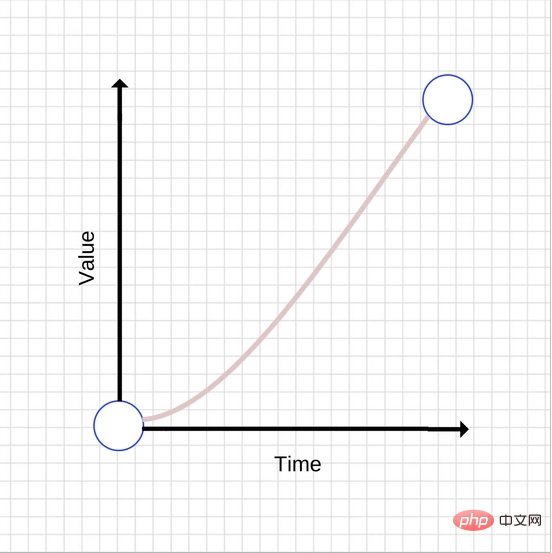
与ease-out动画相比,ease-in可能会让人感到不寻常,由于启动缓慢给人以反应卡顿的感觉,因此会产生一种无反应的感觉。 动画结束很快也会产生一种奇怪的感觉,因为整个动画正在加速,而现实世界中的物体在突然停止时往往会减速。
和ease-out和linear动画类似,使用 CSS 关键字来实现 ease-in 动画:
transition: transform 500ms ease-in;
该动画为 ease-in 和 ease-out 的合集,过渡效果图如下:
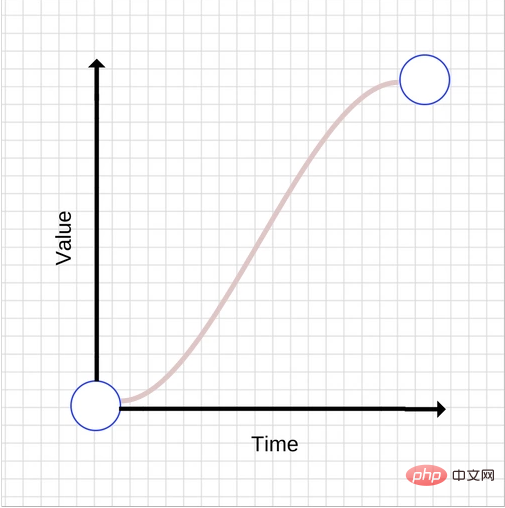
不要使用太长的动画持续时间,因为它们会让你的 UI 感觉没有响应。
用ease-in-outCSS 关键字来实现ease-in-out动画:
transition: transform 500ms ease-in-out;
你也可以定义自己的easing曲线,这可以更好地创建自己想要的动画效果。
实际上,ease-in,linear及ease关键字映射到预定义 贝塞尔曲线 ,可以在 CSS transitions specification 和 Web Animations specification 中查找更多关于贝塞尔曲线的内容。
Bézier curve(贝塞尔曲线)是应用于二维图形应用程序的数学曲线。 曲线定义:起始点、终止点(也称锚点)、控制点。通过调整控制点,贝塞尔曲线的形状会发生变化。 1962年,法国数学家Pierre Bézier第一个研究了这种矢量绘制曲线的方法,并给出了详细的计算公式,因此按照这样的公式绘制出来的曲线就用他的姓氏来命名,称为贝塞尔曲线。
CSS3 transition-timing-function 属性,其语法如下:
transition-timing-function: linear|ease|ease-in|ease-out|ease-in-out|cubic-bezier(n,n,n,n);
总而言之可以用cubic-bezier(n,n,n,n)的形式来表示全部的属性值,这里就涉及到贝塞尔曲线(Bézier curve)。
让我们看看贝塞尔曲线的工作原理。 贝塞尔曲线需要四个值,或者更准确地说它需要两对数字。 每对描述立方贝塞尔曲线控制点的X和Y坐标。贝塞尔曲线的起点有一个坐标(0, 0),结束坐标是(1, 1)。 你可以设置两个对号,两个控制点的X值必须在[0,1]范围内,并且每个控制点的Y值可以超过 [0,1] 限制,尽管规定不清楚多少。
即使每个控制点的X和Y值稍有变化,也会得到完全不同的曲线。让我们看两张贝塞尔曲线的图,两张图相近但坐标的控制结点却不同。

和
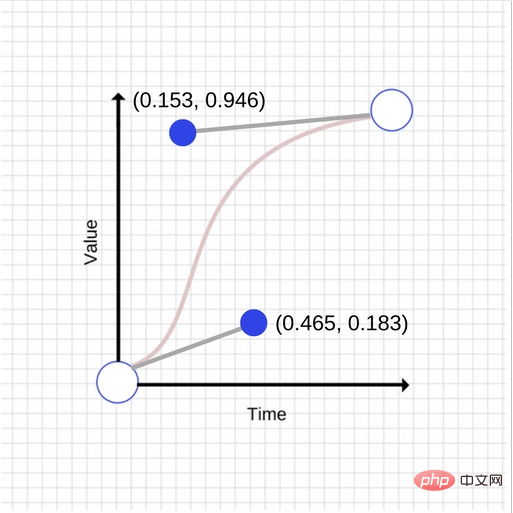
如您所见,两张图有很大的不同, 第一个控制点矢量差为(0.045,0.183)矢量差,而第二控制点矢量差为(-0.427, -0.054)。
第二条曲线的样式为:
transition: transform 500ms cubic-bezier(0.465, 0.183, 0.153, 0.946);
前两个数字是第一个控制点的X和Y坐标,后两个数字是第二个控制点的X和Y坐标。
当你在使用动画的时候,你应该维持 60 帧每秒,否则会影响用户体验。
和世界上的其他事物一样,动画也会有性能的开销。一些属性的动画性能开销相比其它属性要小。例如,为元素的width和height做动画会更改其几何结构并且可能会造成页面上的其它元素移动或者大小的改变,这个过程称为布局。我们在之前的一篇文章 中更详细地讨论了布局和渲染。
通常,你应该避免动画触发布局或重绘的属性。 对于大多数现代浏览器,这意味着把动画局限于opacity和transform属性。
你可以使用 will-change 知浏览器你打算更改元素的属性,这允许浏览器在进行更改之前进行最适当的优化。但是,不要过度使用will-change,因为这样做会导致浏览器浪费资源,从而导致更多的性能问题。
will-change用法如下:
.box { will-change: transform, opacity; }
该属性在 Chrome, Firefox,Opera 得到很好的兼容。

transforms和opacity,这时整个CSS动画得以在合成线程完成(而JS动画则会在主线程执行,然后触发合成线程进行下一步操作),在 JS 执行一些昂贵的任务时,主线程繁忙,CSS 动画由于使用了合成线程可以保持流畅transforms和opacity属性值的更改。如果动画只是简单的状态切换,不需要中间过程控制,在这种情况下,css 动画是优选方案。它可以让你将动画逻辑放在样式文件里面,而不会让你的页面充斥 Javascript 库。然而如果你在设计很复杂的富客户端界面或者在开发一个有着复杂 UI 状态的 APP。那么你应该使用 js 动画,这样你的动画可以保持高效,并且你的工作流也更可控。所以,在实现一些小的交互动效的时候,就多考虑考虑 CSS 动画。对于一些复杂控制的动画,使用 javascript 比较可靠。
The above is the detailed content of Detailed explanation of the underlying principles of CSS and JS animation and how to optimize their performance. For more information, please follow other related articles on the PHP Chinese website!